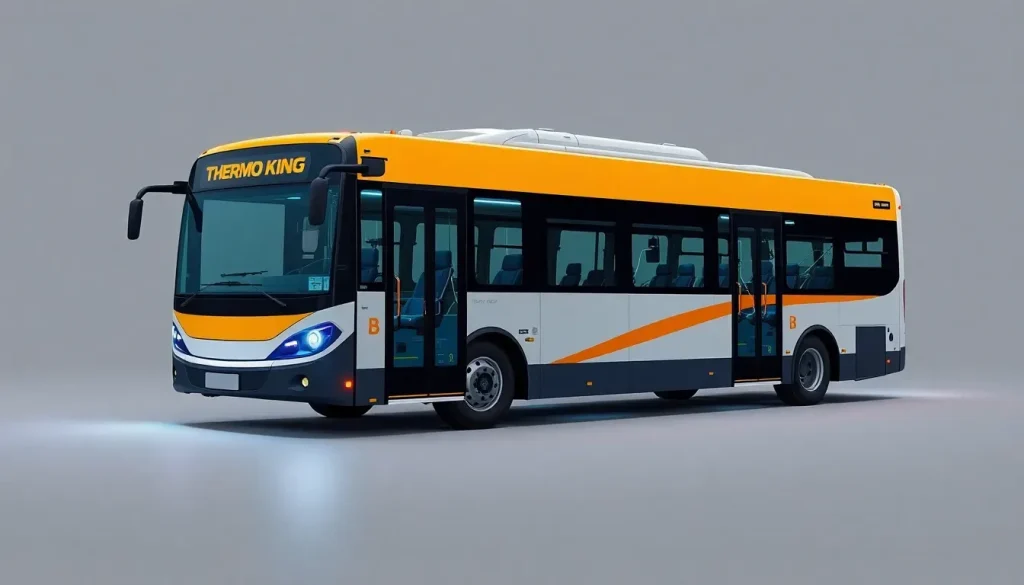Thermo King Launches TE Series Heat Pump for Electric Buses

In the quest for sustainable public transport solutions, Thermo King, a notable brand under Trane Technologies, has unveiled an innovative solution that could revolutionize electric bus operations in diverse climates. The TE Series Heat Pump promises not only to enhance the operational range of electric buses but also to ensure passenger comfort while contributing to a considerable reduction in emissions. This article delves into the features and benefits of the TE Series, shedding light on its significance in the electric bus industry.
- Enhancing the Range of Electric Buses
- Adapting to Cold Weather: Improving Battery Performance
- Reducing Carbon Emissions: A Step Towards Eco-Friendly Transit
- Global Adoption: Which Countries Lead in Electric Bus Usage?
- Heating Solutions for Electric Buses: Understanding the Mechanism
- Conclusion: The Future of Electric Bus Technology
Enhancing the Range of Electric Buses
Electric buses have been a part of public transit systems for over a decade, but their effectiveness has often been hampered by traditional heating methods. Conventional resistance heaters draw significant power from the vehicle's batteries, thus limiting their operational range and efficiency.
The TE Series Heat Pump from Thermo King is a groundbreaking innovation that leverages the company’s extensive expertise in heat pump technology. This system promises to be a game changer, offering up to 2.5 times more efficiency compared to standard resistance heaters. Such efficiency translates to a marked increase in the operational range of electric buses:
- At moderate temperatures (around 40°F), buses can achieve up to 50% more range per charge.
- In colder temperatures (approximately 20°F), this increase can still reach an impressive 30%.
Chris Tanaka, vice president of product management for Thermo King Americas, emphasizes the importance of this product, stating, “This product is a critical step in continuing to make public transportation more efficient, reliable, and eco-friendly.” The TE Series is not merely about extending range; it embodies the principles of sustainability and operational excellence in public transport.
Adapting to Cold Weather: Improving Battery Performance
One of the standout features of the TE Series Heat Pump is its ability to maintain passenger warmth in temperatures as low as 20°F without requiring auxiliary heating sources. This is particularly crucial for areas that experience harsh winters, where traditional heating solutions may fall short.
By minimizing the need for backup heating, the TE Series Heat Pump allows for:
- Extended route options during colder months.
- Decreased frequency of battery recharges, which can lead to increased operational efficiency.
- Reduced emissions at the power source, aligning with global decarbonization goals.
The system includes automated comfort controls that manage heating, defrosting, and auxiliary heating modes, streamlining operations and enhancing passenger safety and comfort.
Reducing Carbon Emissions: A Step Towards Eco-Friendly Transit
The introduction of the TE Series Heat Pump marks a significant milestone in the effort to reduce carbon emissions associated with public transport. Unlike diesel heaters, which emit pollutants directly into the atmosphere, the TE Series operates without generating any direct emissions. This feature is crucial for transit authorities aiming to meet stringent environmental standards.
The energy efficiency of the TE Series also contributes to a reduction in indirect emissions linked to electricity generation. By consuming less energy overall, electric buses equipped with this system can significantly lower their carbon footprint.
Global Adoption: Which Countries Lead in Electric Bus Usage?
As the push for sustainable transport solutions grows, several countries are leading the charge in adopting electric buses. Among the frontrunners, we find:
- China: Currently holds the largest fleet of electric buses globally, with a significant investment in electric vehicle infrastructure.
- United States: Many cities are transitioning to electric buses to improve air quality and reduce dependence on fossil fuels.
- Germany: Aiming for extensive electrification, Germany is investing heavily in electric public transport systems.
- Norway: A pioneer in electric mobility, with many cities committing to fully electrifying their bus fleets.
This global trend highlights the increasing recognition of the benefits of electric buses, including their potential to reduce urban air pollution and greenhouse gas emissions.
Heating Solutions for Electric Buses: Understanding the Mechanism
Heating electric buses in cold weather has been a challenge due to the significant energy demands of traditional heating systems. The TE Series Heat Pump addresses this issue through its innovative design, which extracts heat from the ambient air, even in colder temperatures. Here’s how it works:
- The heat pump circulates refrigerant through a closed loop.
- As the refrigerant absorbs heat from the air, it converts from a liquid to a gas.
- This gas is then compressed, increasing its temperature before it is circulated into the bus’s heating system.
- As it releases heat into the bus, it returns to a liquid state, ready to absorb more heat.
This cycle allows the TE Series to operate efficiently, providing warmth without draining the vehicle's battery excessively.
Conclusion: The Future of Electric Bus Technology
The TE Series Heat Pump from Thermo King exemplifies the future of electric bus technology, combining efficiency, passenger comfort, and sustainability. As cities worldwide strive towards greener public transport solutions, innovations like the TE Series will play a pivotal role in shaping the future of urban mobility.
For a deeper dive into the technology and its applications, check out this insightful video:




Leave a Reply